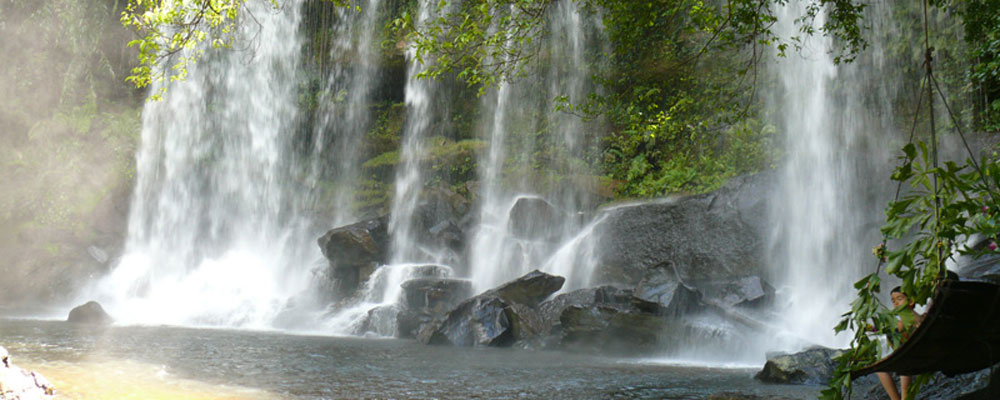
Phnom Kulen Mountain
…is located 30 km northwards from Angkor Wat. Its name means “mountain of the lychees”. There is a sacred hilltop site on top of the range.
Phnom Kulen is considered a holy mountain in Cambodia, of special religious significance to Hindus and Buddhists who come to the mountain in pilgrimage.
It also has a major symbolic importance for Cambodians as the birthplace of the ancient Khmer Empire, for it was at Phnom Kulen that King Jayavarma II proclaimed independence from Java in 804 CE. Jayavarman II initiated the cult of the king, a linga cult, in what is dated as 804 CE and declaring his independence from Java of whom the Khmer had been a vassalage state (whether this is actually “Java” or “Lava” (a Lao kingdom) is debated, as well as the legend that he was earlier held as a ransom of the kingdom in Java. See Higham’s The Civilization of Angkor for more information about the debate). During the Angkorian era the relief was known as Mahendraparvata (the mountain of Great Indra).
The site is known for its carvings representing fertility and its waters which hold special significance to Hindus. Just 5 cm under the water’s surface over 1000 small carvings are etched into the sandstone riverbed. The waters are regarded as holy, given that Jayavarman II chose to bathe in the river, and had the river diverted so that the stone bed could be carved. Carvings include a stone representation of the Hindu god Vishnu laying on his serpent Ananta, with his wife Lakshmi at his feet. A lotus flower protrudes from his navel bearing the god Brahma. The river then ends with a waterfall and a pool.
Near these mountains is Preah Ang Thom, a 16th century Buddhist monastery notable for the giant reclining Buddha, the country’s largest.
The Samré tribe was formerly living at the edge of Phnom Kulen, quarrying sandstone and transporting it to the royal sites.
The Khmer Rouge used the location as a final stronghold as their regime came to an end in 1979.
Chup Preah is a stream flowing into the mountain’s valley. Ku Len Mountain has two waterfalls. The first is between four and five metres high with a diameter of 20 to 25 metres. The second waterfall is 15 to 20 metres high and has a diameter of 10 to 15 metres. These sizes apply to the dry and rainy seasons.
Preah Ang Thom houses a large statue of Buddha. It was built in the 16th century and is eight metres high. Preah Ang Thom is the sacred and worshipping god for Ku Len Mountain. There are also two large Cham Pa trees nearby. Besides Preah Ang Thom, Chhok Ruot, footprints of Preah Bat Choan Tuk, Peung Chhok, Peung Ey So and Peung Ey Sey, can also be seen.
The Linga is along the river of Siem Reap and has a lot of figures of Yoni and Linga spreading out at the bottom of the river.
The Terrace of Sdach Kum Ling has a small brick-built ruined temple in its centre. It was covered by lava for hundreds of years.
